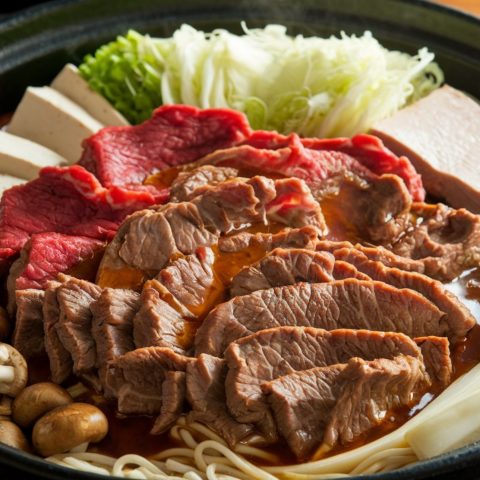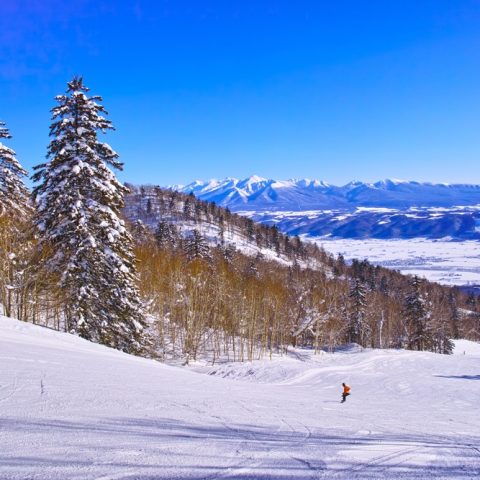
Sukiyaki? The word might ring a bell to some as the alternative title to Kyu Sakamoto’s 60s hit song, “Ue O Muite Arukou”. Yet it has nothing to do with the song: sukiyaki is actually a type of meat hotpot, commonly made with thinly-sliced beef in a low skillet. It’s a communal food, usually eaten with friends or family. As sukiyaki is usually made with high-grade meat, it’s more expensive than your average dinner, and is reserved for special occasions.
The dish itself doesn’t have a very long history, with most scholars only tracing it back to the early Meiji era (1868-1912). Before this, meat, particularly beef, was outlawed in Japan due to religious reasons, and Japan was closed off to most foreigners for two centuries. The Meiji period was a time in which the country was opened up to foreign influences again, including the practice of eating meat, and different styles of cooking. Sukiyaki became one of these dishes.

Where the name comes from is still debated, but the common story is that it refers to a spade, ‘suki’, with ‘yaki’ meaning grilled. In the past, farm workers would cook their catch on actual spades, which then morphed into a proper skillet.
Sukiyaki, shabu shabu, nabe – what’s the difference?
For starters, both sukiyaki and shabu shabu are a type of nabemono, or hot pot dishes. The primary difference between shabu shabu and sukiyaki is that the former can be had with a wide variety of dipping sauces, while the latter is eaten with a dip of raw egg. Sukiyaki is also cooked in a very rich, sweet broth made of sugar, sake or mirin (sweet rice wine), and soy sauce. Shabu shabu, on the other hand, is made with a light broth, sometimes only using the cooked meat as flavouring. Think of sukiyaki as shabu shabu’s gusty brother, with the ingredients taking on the sweet flavour of the rich both, while shabu shabu is a bit more delicate.

Besides meat – most often beef, but you find the occasional pork or chicken version too – the most popular ingredients for sukiyaki include negi (Welsh onions or Japanese leek), seared tofu, shiitake mushrooms, and konnyaku noodles known as shirataki. Adding in udon to soak up the remaining broth and finish the meal is common too.
How to eat Sukiyaki?
Kanto Vs Kansai
It wouldn’t be a Japanese dish if there weren’t some east-west regional differences. In Kanto, the region around Tokyo, sukiyaki is made by first adding a sauce to the pan made with soy sauce, mirin and/or sake, sugar, and dashi stock, known as warishita. All the other ingredients, including the meat, are then slowly cooked in the broth. In Kansai, it’s meat first, with the soy, sake, and sugar added in when the meat is nearly done, while the vegetables and other ingredients of choice are put in last.
Whether you’re doing for Kanto or Kansai style sukiyaki, you’ll still end up dipping the ingredients into a ‘dip’ of raw egg yolk before guzzling it all up. You might receive the egg still whole when you sit down—just crack it open into the small bowl, and give it a quick scramble with your chopsticks before dunking in the meat.

Where to have it?
A newcomer in the Tokyo scene is Kasuitei, with locations in Roppongi, Shinbashi, and Kyobashi. Sukiyaki courses start at 5000 yen per person, which is a good value considering the location and the quality of their meat of choice, dry-aged wagyu. (Disclaimer: Arigato Japan was recently invited to the Roppongi branch). It’s a great place to get an introduction into sukiyaki. The traditional Japanese setting adds to the feeling of it being a special occasion.

More about Kasuitei Restaurant:
Website: https://kasuitei.jp/en/
The one we tried was the Roppongi Branch and is located here: 〒106-0032 Tokyo, Minato City, Roppongi, 6 Chome−7−7 MERCURY六本木1・2F
It’s open from Monday to Saturday, from 11:30 to 14:30 (lunch) and then from 18:00 to 23:00 (dinner).



